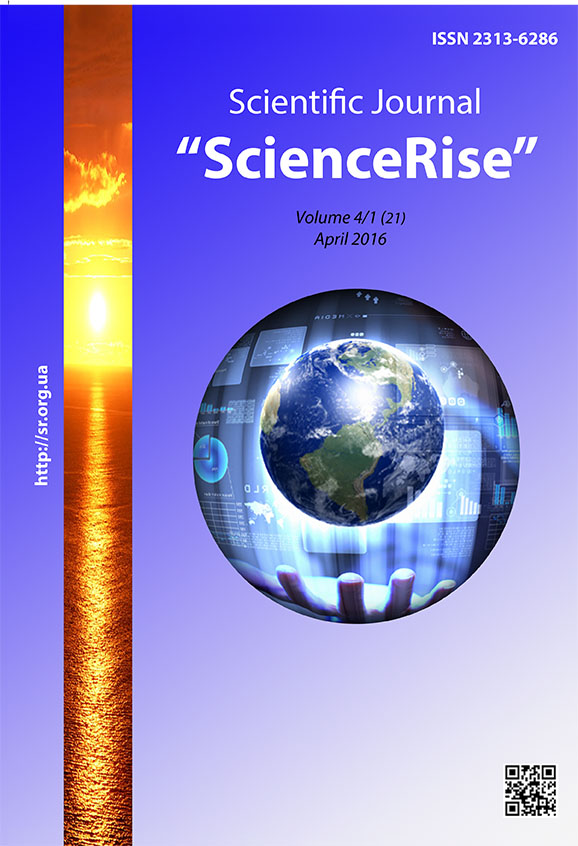Analysis of eco-geographical features of the centers of Triticum spelta origin and perspectives of culture expansion in Ukraine
DOI:
https://doi.org/10.15587/2313-8416.2016.66199Keywords:
spelt, GIS, modeling, bioclimatic indices, centers of origin, Triticum spelta, gliadinsAbstract
Study of the features of eco-geographical centers of Triticum spelta origin indicates high ecological plasticity for "wild plant of alpine plains". Limiting factors that determine the possibility of the plant to grow, reproduce and show desirable properties in Ukraine are the maximum temperature of the warmest month and pH of the soil
References
Flyaksberher, K. A. (1935). Wheat. Vol. 1. Moscow; Leningrad: Gos. Publishing House kolhoznoy and sovhoznoy lit-ry, 262.
Zhukovski, P. М. (1971). Cultural plants and their relatives. Leningrad: Kolos, 448.
Kuckuck, H., Schiemann, E. (1957). Über das Vorkommen von Spelt und Emmer (Triticum spelta L. und T. dicoccum Schübl.) im Iran. Z. Pflanzenzüchtung, 38, 3833–3896.
Kihara, H., Yamashita, K., Tanaka, M. (1965). Morphological, physiological, genetical and cytogenetical studies in Aegilops and Triticum collected from Pakistan, Afghanistan and Iran. Results Kyoto Univ. Sci. Exp., 1, 1–118.
Mustafaev, I. D. (1964). Wheats of Azerbaijan and their value are in a selection and process of formation of forms. Bobrovsk: VNIIS.
Veremeychyk, A., Pashkevich, G. (2004). Peculiarity of ancient settlement in the tract Ovramenko circle. Archaeological research of L’viv University, 7, 270–281.
Romanova, Y. A., Gubareva, N. K., Konarev, А. В. (2001). Research of collection of type of wheat of Triticum spelta on polymorphism of gladin. Geneticist, 37 (9), 1258–1265.
Blatter, R. H. E., Jacomet, S., Schlumbaum, A. (2004). About the origin of European spelt ( Triticum spelta L.): allelic differentiation of the HMW Glutenin B1-1 and A1-2 subunit genes. TAG Theoretical and Applied Genetics, 108 (2), 360–367. doi: 10.1007/s00122-003-1441-7
Species. Global Biodiversity Information Facility. Available at: http://www.gbif.org/species
Data for current conditions (1950–2000). WorldClim – Global Climate Data. Available at: http://www.worldclim.org/current
McFadden, E. S., Sears, E. R. (1946). The origin of Triticum spelta and its free-thresching hexaploid relatives. Jounal of Heredity, 37, 107–116. Available at: http://www.oxfordjournals.org/our_journals/jhered/freepdf/37-107.pdf
Karpun, Y. (2004). Fundamentals yntroduktsyy plants. Hortus botanicus, 2, 17–32. doi: 10.15393/j4.art.2003.168
Characteristics of agricultural land by the reaction of soil solution on the results of 9 agrochemical certification round (2006–2010). Institute of soil conservation Ukraine. Available at: http://www.iogu.gov.ua/pasportizaciya/karty-po-vmistu-pozhyvnyh-rechovyn-rn-humus-fosfor-kalij/
Downloads
Published
Issue
Section
License
Copyright (c) 2016 Віталій Васильович Лапчинський

This work is licensed under a Creative Commons Attribution 4.0 International License.
Our journal abides by the Creative Commons CC BY copyright rights and permissions for open access journals.
Authors, who are published in this journal, agree to the following conditions:
1. The authors reserve the right to authorship of the work and pass the first publication right of this work to the journal under the terms of a Creative Commons CC BY, which allows others to freely distribute the published research with the obligatory reference to the authors of the original work and the first publication of the work in this journal.
2. The authors have the right to conclude separate supplement agreements that relate to non-exclusive work distribution in the form in which it has been published by the journal (for example, to upload the work to the online storage of the journal or publish it as part of a monograph), provided that the reference to the first publication of the work in this journal is included.

